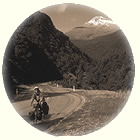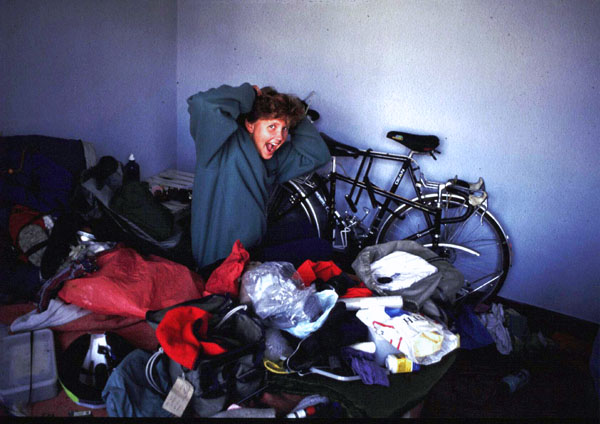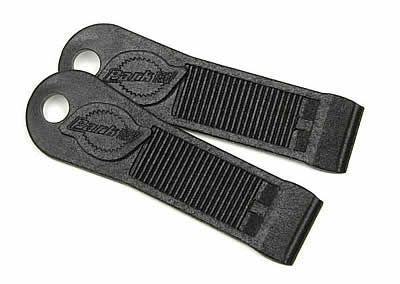
Equipment and Packing
created 11 August 2009/updated 17 July 2017.
 |
Equipment and Packingcreated 11 August 2009/updated 17 July 2017. |

Janet packing for the off, Thamel, Kathmandu, November 1992
We left the UK with too many items (the snakebite kit?) but we have now refined our preparations and routines on our own and with the help of our sea kayaking coach, Howard Jeffs :-
Think carefully about what you really need. You may be able to find it at your destination, but doing so could tie you up for days at a time. A classic case is a freewheel tool remover for your particular brand of rear hub - we found one really difficult to find in Greece, and had to make a special trip to Athens for one, things get more difficult in the Third World.
The less you have, the happier you'll be. If travelling alone, it's a real hassle to carry a large bag around with valuables in it each time you have to leave the bike outside, so try to keep the luxuries to a bare (and replaceable) minimum.
Leave space for extra items - you may find that you need to pack away extra food, water, or clothes for some legs of the trip and it feels better not to have these strapped across the back of the bike.
If you use a Thermarest, try to avoid blowing in up with your breath - store it inflated and let it self-inflate while you are setting up your tent because the moisture in your breath really plays havoc with the foam and can't escape. You don't need to seal the valve on your Thermarest until you go to sleep, and it doesn't need to be fully inflated for you to be comfortable, we often find we have to let some air out to sleep comfortably.
If you plan to use a MSR stove inside your tent, then lighting and flair-ups can be very dangerous. Only allow a small amount of fuel into the warming pan under the generator tube and when that goes out, crack the valve open for a moment or two and let another dribble of fuel into the stove line, then let that burn through and repeat - this may need to be repeated several times but the procedure does keep flames much smaller during the priming phase. Invert the stove when you've finished using it so that fuel in the line drains to the burner and gets burnt before the stove is taken apart. This stops fuel contamination of your gear.
Stuff the foot of your sleeping bag into am airtight stuffsack first and turn the sleeping bag inside out if it has a Goretex or water-resistant cover because it is much harder to get the air out of it if the outer shell is not porous.
A properly waterproof footprint to go under the groundsheet of your tent makes a massive difference to the amound of condensation you'll have to deal with if you pitch your tent on grass or damp ground.
Ripstop nylon for tents is best repaired using parachute repair tape, which is
self-adhesive. Surfaces do need to be dry though. Try
Never pull Easton tent poles out of sleeves on the tent, only ever push. And make sure that you fold poles from the middle when separating them to protect the elastic from excessive stretching. It makes sense to keep at least two spare pole repair sleeves in your repair kit. Check that the tips of the poles come out of the end of the Easton poles before you go on a trip because you won't be able to repair the poles or elastic if the tips have corroded into the poles. Silicone spray helps here.
If you are kayaking or cycling in really wet conditons, you can make packing easier if you use a roll of smallish bin-bags to line your nylon stuffsacks rather than splurging on Ortlieb roll-top bags that are difficult to squeeze into small spaces when full. It sounds cheapskate but it works surprisingly well.
Pack items in the same place in each bag each day - preferably in dry bags (canoe bags) inside your panniers if there's any risk of rain or river crossings. It's comforting to know that if you have a puncture you'll be able to lay your hands on a patch kit without emptying everything out onto the roadside. Small plastic sealable boxes can help to group easily lost items together and prevent things like toothpaste tubes and shampoo bottles from being subjected to undue pressure.
Looking for the instruction manuals? They're here on the manuals page.
Some things can make a real difference but are hard to find. Here's a suggested list of people who can help :-
http://www.stanfords.co.uk - map and travel bookstore just off Covent Garden market in London. Most useful for maps of out-of-the way areas that the other bookstores scratch their heads at when you ask for them.
http://www.carradice.co.uk - a great British institution; they make the best panniers and saddlebags. Ortlieb's bags are also good, but not quite so spacious or as repairable. A bleached, tatty Carradice bag in faded black duck cotton, mmmmm!
http://www.globetrotter.de - Mike and Regina kitted themselves out here for their tow-a-boat tour of Scandinavia in 2004; they have a pool you can try kayaks out in, and a freezer room for testing sleeping bags at different temperatures! Needless to say their catalogue puts any outdoor supplier in the UK to shame and their prices are pretty reasonable too.
http://www.roseversand.de - best cycling store on the web, and you can buy in English or French here too. They are quick to dispatch items and service seems to be faultless. Plus they again have more bicycle gadgets for touring bikes than you can shake a stick at.
http://www.chocolatefish.co.uk - specialise in Merino wool base layer clothing at reasonable prices. Their website tells you everything else you could possibly need to know about why Merino wool is a better choice than synthetics for this.
http://www.proadventure.co.uk - excellent customer service for mail order items for bushcraft, such as sturdy and razor sharp knives from A. Wright for the outdoors (the most similar I could find to Ray Mears's own model). Llangollen based, Proadventure also organise training courses and bushcraft events in the Welsh hills.
http://www.alpkit.com - Good down duvet jackets and sleeping bags at factory door prices rather than the inflated ones you'll find in outdoor outlets. Also comprehensive coverage of what to look for in a sleeping bag...
http://www.kinetics.org.uk - if you are a Brompton owner, this is the place to visit for a suspension hub and other unusual gizmos.
http://www.sjscycles.com - Robin and his team understand what their customers want and are unsurpassed for stocking replacement parts for bikes bought more than a couple of years ago.
http://www.joebrownsnowdonia.co.uk - Joe Brown's Capel Curig store gets a visit from us whenever we are in North Wales, partly because they still seem to stock things like Dachstein mittens and wooly balaclavas that you can't find anywhere else.
http://www.profabrics.co.uk - Pointnorth (misleadingly named!) provides performance fabrics if you are looking to make your own panniers, clothes, or tent.
http://www.nordic-outdoor.co.uk - sell tents you can socialise in around a fire, axes, and sundry camping equipment.
If you are flying to your destination, you'll probably want to pack in your hand luggage a spanner thin enough to undo a pedal with, and an Allen key suitable for loosening the handlebars so that they can be turned through 90° for the trip out (and the trip back). We prefer to take two fold-out Allen key tools because they are pretty much essential if anything falls off the bike or needs tightening up - make sure that the keys are long enough to reach into the brake hoods of your touring bars if you have drop handlebars, or you could be left in deep trouble if you need to change a broken gear cable or re-centre the brakehood after a spill.
A chain rivet extractor (for shortening broken chains by a link or two) is essential. Some chains (Shimano particularly) require a new rivet to be pressed in to replace the one pushed out; avoid if possible or at least ensure that you have the replacement pin in your toolkit. Tools for removing the shell of the bottom bracket and headset may be worth taking but I'd expect to be able to find an alternative at a garage or repair shop if problems occurred with these en route.
If you have a small wheeled bike (like a Brompton), it's essential to carry a couple of spare inner tubes and its worth taking a tire along too - the tires are a really tight fit on Brompton rims, so use the nylon Park tire levers that are wide and flat, and make sure that you edge the last bit of tire back onto the rim over the valve (where the inner tube is at its smallest, which makes the whole job much easier).

Park-TL2 levers - the only sensible way to get a Brompton tire back on
Duct tape and a reasonably short length of thickish wire is good for fixing broken carrier frames if way out in the boonies. A spare tire can be folded into a neat trefoil shape with a little care and carried inside the front wheel (between the spokes) or bungied onto the back rack - touring bike tires seem to fail suddenly and unexpectedly after years of sterling service, so probably worth taking a spare since 700x28C is unusual these days in most places outside cities.
We've stopped carrying Kryptonite-style U-Locks, preferring to take their heavy-duty cable with a strong, secure padlock instead. It is a little lighter and fits around more street furniture (you just don't find lamp posts, railings, or parking meters for a U-Lock to lock around in developing countries).
Here's a list of things we took on our 2005 tour to Norway.
home cycling
cycling Equipment
Equipment
[ Home | Strictly Business | Near Misses | Cycletouring ]